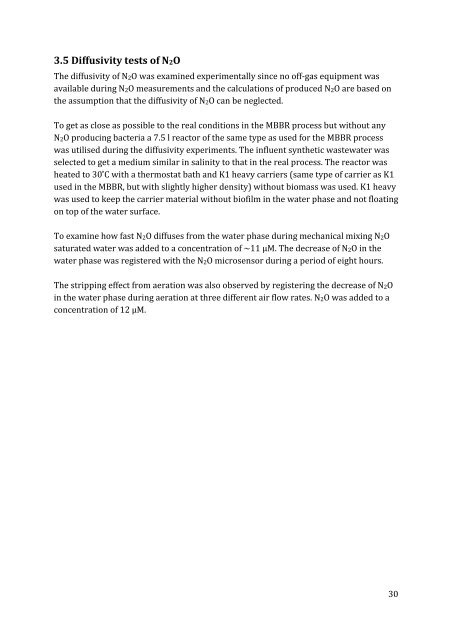N2O production in a single stage nitritation/anammox MBBR process
N2O production in a single stage nitritation/anammox MBBR process
N2O production in a single stage nitritation/anammox MBBR process
You also want an ePaper? Increase the reach of your titles
YUMPU automatically turns print PDFs into web optimized ePapers that Google loves.
3.5 Diffusivity tests of <strong>N2O</strong><br />
The diffusivity of <strong>N2O</strong> was exam<strong>in</strong>ed experimentally s<strong>in</strong>ce no off-gas equipment was<br />
available dur<strong>in</strong>g <strong>N2O</strong> measurements and the calculations of produced <strong>N2O</strong> are based on<br />
the assumption that the diffusivity of <strong>N2O</strong> can be neglected.<br />
To get as close as possible to the real conditions <strong>in</strong> the <strong>MBBR</strong> <strong>process</strong> but without any<br />
<strong>N2O</strong> produc<strong>in</strong>g bacteria a 7.5 l reactor of the same type as used for the <strong>MBBR</strong> <strong>process</strong><br />
was utilised dur<strong>in</strong>g the diffusivity experiments. The <strong>in</strong>fluent synthetic wastewater was<br />
selected to get a medium similar <strong>in</strong> sal<strong>in</strong>ity to that <strong>in</strong> the real <strong>process</strong>. The reactor was<br />
heated to 30 ̊C with a thermostat bath and K1 heavy carriers (same type of carrier as K1<br />
used <strong>in</strong> the <strong>MBBR</strong>, but with slightly higher density) without biomass was used. K1 heavy<br />
was used to keep the carrier material without biofilm <strong>in</strong> the water phase and not float<strong>in</strong>g<br />
on top of the water surface.<br />
To exam<strong>in</strong>e how fast <strong>N2O</strong> diffuses from the water phase dur<strong>in</strong>g mechanical mix<strong>in</strong>g <strong>N2O</strong><br />
saturated water was added to a concentration of ~11 µM. The decrease of <strong>N2O</strong> <strong>in</strong> the<br />
water phase was registered with the <strong>N2O</strong> microsensor dur<strong>in</strong>g a period of eight hours.<br />
The stripp<strong>in</strong>g effect from aeration was also observed by register<strong>in</strong>g the decrease of <strong>N2O</strong><br />
<strong>in</strong> the water phase dur<strong>in</strong>g aeration at three different air flow rates. <strong>N2O</strong> was added to a<br />
concentration of 12 µM.<br />
30















